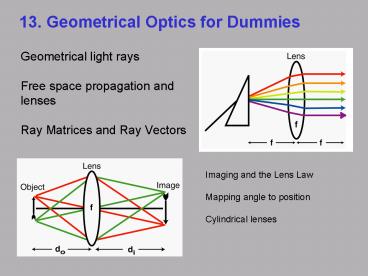13' Geometrical Optics for Dummies PowerPoint PPT Presentation
1 / 18
Title: 13' Geometrical Optics for Dummies
1
13. Geometrical Optics for Dummies
- Geometrical light rays
- Free space propagation and lenses
- Ray Matrices and Ray Vectors
Imaging and the Lens Law Mapping angle to
position Cylindrical lenses
2
Ray Optics
xin, qin
axis
xout, qout
We'll define "light rays" as directions in space,
corresponding, roughly, to k-vectors of light
waves. Each optical system will have an axis,
and all light rays will be assumed to propagate
at small angles to the axis.
3
Ray Optics
xin, qin
xout, qout
- A light ray can be defined by two co-ordinates
its position, x its slope, q
optical ray
q
x
Optical axis
These parameters will change with distance and as
the ray propagates through optics.
4
Ray Matrices Ray Vectors
- For many optical components, we can define 2x2
"Ray Matrices." - The effect on a ray is determined by multiplying
its "Ray Vector."
Ray matrices can describe simple and com- plex
systems.
Optical system ? 2x2 Ray matrix
These matrices are often called "ABCD Matrices."
5
Ray matrices as derivatives
Since the displacements and angles are assumed to
be small, we can think in terms of partial
derivatives.
Its easy to evaluate these derivatives for most
optical components.
6
Ray matrices as derivatives
We can write these equations in matrix form.
spatial magnification
angular magnification
7
Rays in free space or a medium
- If xin and qin be the position and slope upon
entering, let xout and qout be the position and
slope after propagating from z 0 to z.
Rewriting this expression in matrix notation
8
Rays at a lens
If the lens is thin, then only the ray slope
changes.
xout xin qout (1/f) xin qin
Rewriting this expression in matrix notation
9
Ray Matrices for Space and Lenses
- Free space
z
Lens
f
10
Ray Matrix for an Interface
- At the interface, clearly
- xout xin.
- Now calculate qout.
- Snell's Law says n1 sin(qin) n2
sin(qout) - which becomes for small angles n1 qin n2
qout
Þ qout n1 / n2 qin
11
Ray Matrices for Curved Mirrors
- Consider a mirror with radius of curvature, R
- On axis
- Off axis
- where Re R cosq if in plane of incidence
("tangential") - and Re R / cosq if to plane of incidence
("sagittal")
12
For cascaded elements, multiply ray matrices
O2
O1
O3
Notice that the order looks opposite to what it
should be.
13
A system images an object when B 0.
- When B 0, all rays from a point xin arrive at a
point xout, independent of angle.
xout A xin
A is the magnification.
14
The Lens Law
- From the object to
- the image, we have
- 1) A distance d0
- 2) A lens of focal length f
- 3) A distance di
15
Lenses can also map angle to position.
- From the object to
- the image, we have
- 1) A distance f
- 2) A lens of focal length f
- 3) A distance f
So And this arrangement maps position to
angle
16
Cylindrical lenses
- A "spherical lens" focuses in both transverse
directions. - A "cylindrical lens" focuses in only one
transverse direction. - Examples of cylindrical lenses
When using cylindrical lenses, we must perform
separate Ray Matrix analyses, one for each
transverse direction.
17
Application of geometrical optics and other
stuff my latest invention
This simple little device measures ultrashort
laser pulses, as short as 20 femtoseconds.
18
A more detailed view
Lens images position in crystal (i.e., delay, t)
to horizontal position at camera
Top view
Imaging Lens
Camera
Cylindrical lens
Fresnel Biprism
Thick SHG Crystal
Lens maps angle (i.e., wavelength) to
vertical position at camera
FT Lens
Side view

